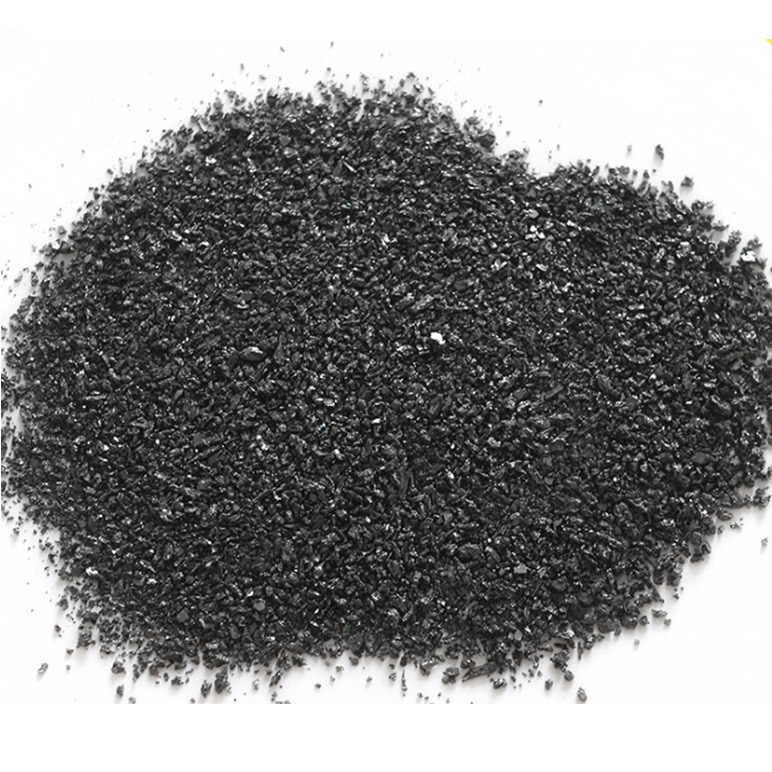The foundry used silicon carbide to cut costs
2019-10-14
Silicon carbide is a compound consisting of one carbon atom and one silicon atom, with silicon accounting for 70% and carbon occupying 30% (by weight).As it dissolves in the presence of slag, carbon and silicon atoms are released as charged ions (c-4 and Si +4), so it is an effective deoxidizer widely used in electric steelmaking.When it is added to gray iron, ductile iron or malleable iron, it not only dissolves easily, but also causes carbon and silicon to enter the melt as an alloy.

When the temperature is below 1620℃, the carbon ACTS as a deoxidizer, so that less stable oxides such as FeO and MnO can be reduced by the reaction SiC+FeO=Si+Fe+CO.When the temperature is higher than 1620 ° c (for example, when steel is made), silicon will do all the deoxidizing, while carbon will act as a carbon increaser and the yield can reach 100%.Coreless induction smelting of iron is the main application field of silicon carbide.About 95% of the coreless induction furnaces in the United States use SiC as the primary source of silicon.In gray iron, nodular iron and malleable iron, SiC+FeO=Si+Fe+CO is used to reduce the content of FeO and MnO in slag.
Since the presence of FeO lowers the melting point of any slag, a drop in the melting point of any slag at any given temperature causes more slag to become liquid.For example, when the FeO slag content was 10%, its melting point is 1350-1400 ℃, and under strong stirring effect of coreless induction furnace, the liquid slag will be "homogenization" in the melt, which left of slag in thousands of very small particles in the melt, many of the casting surface defect is the liquidity good high FeO slag and MnO (often called manganese slag silicate) are introduced to the mold.If join SiC, thus reduce the FeO content of the slag to 1 or 2%, its melting point will ascend to 1500-1550 ℃, so in most of the tapping temperature (1500-1550 ℃), the slag or remain as solid, or only a small amount into the liquid, thus keeping a larger monomer in the stove, this makes the slag particles with high rise speed and easy to be ruled out, and make it into the mold casting defects caused by the opportunity to greatly reduced.
The presence of very small feo-sio2 inclusions (olivine) in molten iron is the main reason for the decrease of fluidity, the increase of shrinkage tendency and the increase of white mouth, especially for nodular iron.Thus, by reducing its amount in molten iron, the tendency to increase shrinkage and whiteness can be eliminated.
Since silicon carbide dissolves rather than melts in molten iron, it takes longer to enter the molten iron than FeSi.Due to the longer duration of action, so the recession time increased.Thus, in the case of nodular iron, although furnaces often leave little or no room for silicon, many founders have found it economical to add at least 3-4kg/T of SiC to the charge.What they saw was a decrease in the number of white holes, a decrease in the number of slag defects, an increase in the number of graphite spheres, a decrease in the tendency to shrink, and an increase in the decay time.This is due in part to the substitution of ferrosilicon containing aluminium and carbonizing agents with high N and S content with low residue SiC.
Another use of SiC in nodular iron is the "preincubation" effect of pure magnesium treatment.One of the disadvantages of pure magnesium treatment is that it increases the tendency to produce shrinkage and carbide.Foreign studies show that adding 2kg/TSiC into the treatment package is the most effective way to eliminate this metallurgical problem.
Since the content of FeO in nodular iron slag is higher than that in gray or vermicular iron slag, the problem caused by fluidized slag to nodular iron is more serious than that caused by gray or vermicular iron, the effect of adding SiC to nodular iron is better.
In terms of gray iron and vermicular iron, the metallurgical effects observed in foreign foundries are basically the same as those observed in nodular iron: the amount and fluidity of slag decrease, the number of eutectic groups increases, the tendency of white hole decreases, and the decay time increases.In addition, foreign gray iron and vermicular iron foundry often have enough room for a certain amount of SiC in the furnace charge.The most common addition amount is: gray iron 10-15kg/T, vermicular iron 5-10kg/T.
Many foundries, especially ball iron works, there is a flow to varying degrees of slag defects caused by such issues, but also face a how to satisfy more and more high quality standards and the cost of increasingly fierce competition, therefore, deoxidizer and carburant, and rich in resources of silicon carbide will become our country many foundries slag flow less defects, improve casting quality, reduce the cost of a very important tool.
The application of silicon carbide in today's foundry is not only imperative, but also the general trend.
We can supply you free samples, booklet, laboratory test report, Industry Report, etc
Welcome to our factory and company for a visit!
web:www.sino-stargroup.com
Email:star15@alloyssi.com






